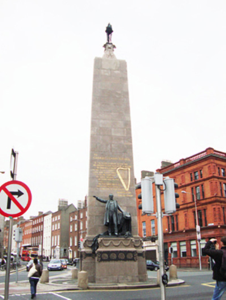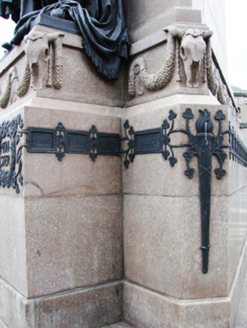Survey Data
Reg No
50010557
Rating
National
Categories of Special Interest
Architectural, Artistic, Historical, Social
Original Use
Monument
In Use As
Monument
Date
1895 - 1915
Coordinates
315815, 234978
Date Recorded
03/11/2011
Date Updated
--/--/--
Description
Freestanding monument, 1899-1911; dated 1906; unveiled 1911, erected under supervision of George Patrick Sheridan (1865-1950) with Shantalla granite obelisk designed by Henry Bacon (1866-1924) and cast-bronze statue by Augustus Saint-Gaudens (1848-1907). Located at north end of O'Connell Street on cobbled island site. Polished Shantalla granite ashlar block construction to tapering obelisk set on raised pedestal with applied bronze decoration and panels naming counties of Ireland and abutted to south by projecting granite pedestal with bronze decoration and lettering naming provinces. Above pedestal is continuous carved festoon with bucrania to corners. South projecting pedestal supports figurative bronze statue of Charles Stewart Parnell (1846-91) with outstretched arm. South face of obelisk has gilt inscription: "TO CHARLES STEWART PARNELL/NO MAN HAS A RIGHT TO FIX THE/BOUNDARY TO THE MARCH OF A NATION/NO MAN HAS A RIGHT/TO SAY TO HIS COUNTRY/THUS FAR SHALL THOU/GO AND NO FURTHER/WE HAVE NEVER ATTEMPTED TO FIX/THE NE-PLUS-ULTRA/TO THE PROGRESS OF/IRELANDS NATIONHOOD/AND WE NEVER SHALL" and "Go soirbhighidh Dia/Éire dá clainn [May God make Ireland flourish for her people]" in Cló Gaelach. Obelisk surmounted by decorative cusped capital supporting bronze tripod and eternal bronze flame. Monument stands on round traffic island with interlocking granite kerbing and cobbles protected by squat domed granite bollards.
Appraisal
Standing nineteen metres high, this monument caused controversy and mixed reactions when unveiled on 1st October 1911. Executed in the neo-Classical Revival style, an American influence brought by the American architect, Henry Bacon (1866-1924), and the Irish-American sculptor, Augustus Saint-Gaudens (1848-1907), the monument commemorates the constitutional nationalist, Charles Stewart Parnell (1846-91), and is of architectural, artistic, historic and social importance while adding to the varied collection of monuments that adorn the entire streetscape of Dublin's principal avenue.















